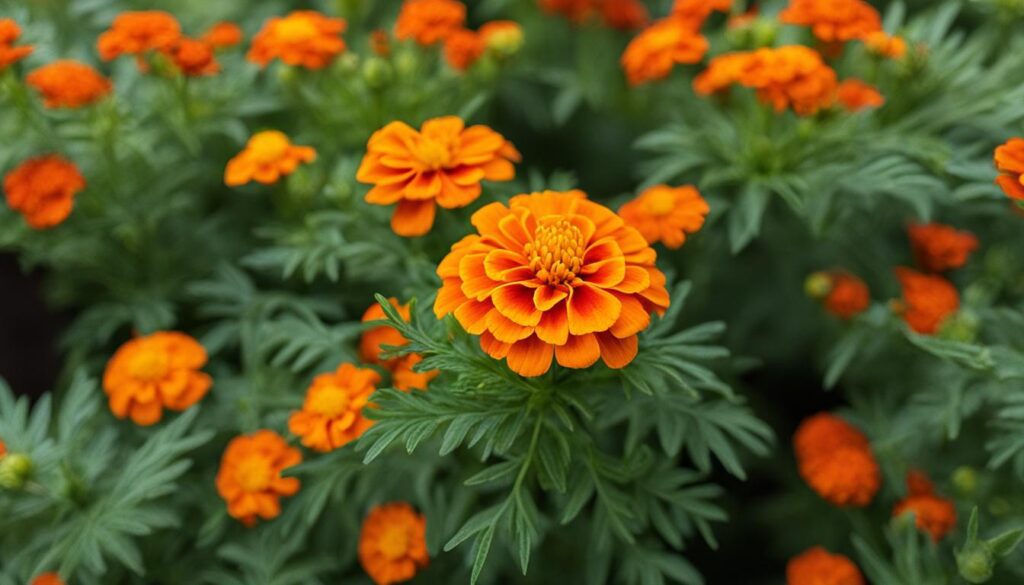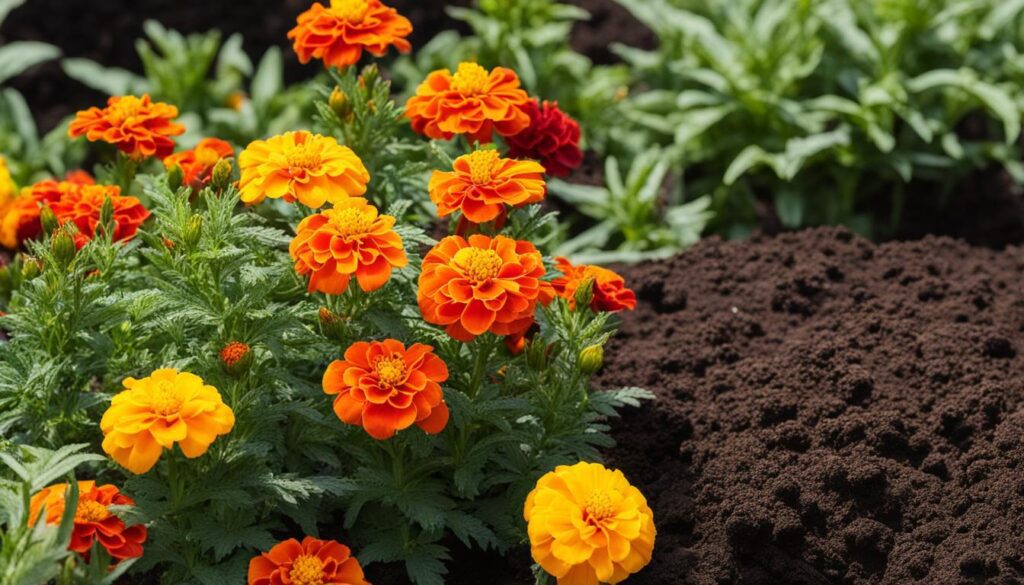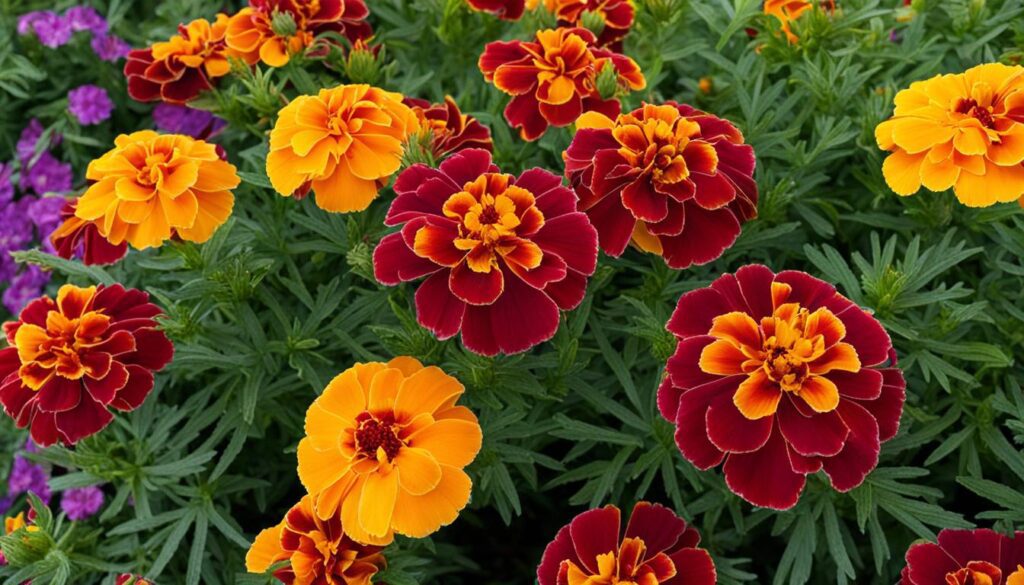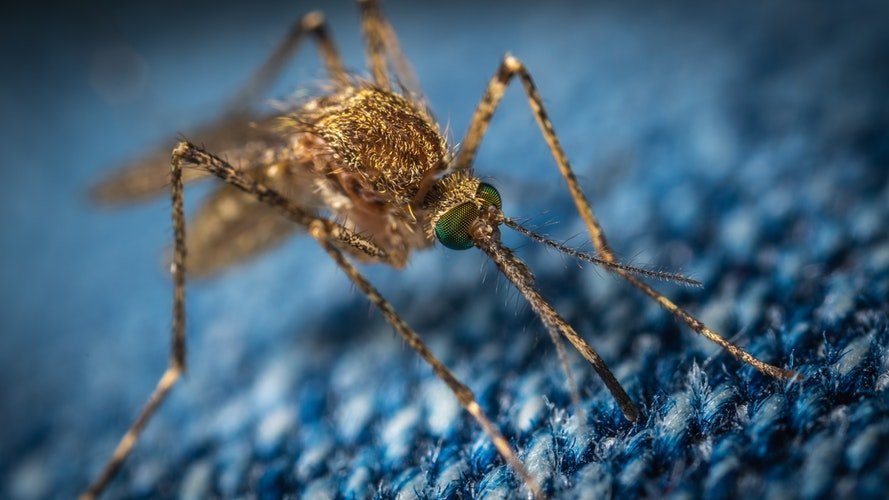French marigolds are a delightful addition to any garden, known for their enduring charm, vibrant colors, and fragrant blossoms. These perennial flowers have the ability to elevate the aesthetics of your garden and bring joy to your outdoor space.
Key Takeaways:
- French marigolds are a popular choice for gardens due to their vibrant colors and frilly blossoms.
- They are unique because they can return year after year as a perennial under certain conditions.
- These marigolds come in various shades of red, orange, and yellow, with pom-pom-like double or single flowers.
- French marigolds have a spicy, herbal flavor and a noticeable scent.
- They not only enhance the beauty of your garden but also serve practical purposes, such as repelling pests and suppressing weeds.
What Are French Marigolds?
French marigolds, belonging to the Asteraceae family, are a delightful addition to any garden. Known for their dentate oblong leaves, these marigolds display a unique mounding growth habit, making them stand out among other marigold species. With a wide range of color options, including shades of red, orange, and yellow, French marigolds add a vibrant burst of color to any landscape.
One of the distinctive features of French marigolds is their heavily ruffled petals, giving them an eye-catching appearance. These flowers are generally one or two inches across, making them perfect for adding a touch of beauty to garden beds or containers. Additionally, French marigolds are not just visually appealing; they are also edible. With a spicy flavor reminiscent of orange peel and a hint of mint, their petals can be used to enhance culinary creations or add a unique twist to salads or teas.
French marigolds have various beneficial properties, making them a popular choice for gardeners. They are known for their ability to repel pests, including invasive insects, due to their strong fragrance. The roots of French marigolds also work to repel nematodes in the soil, making them an ideal companion plant for vegetables and other flowers. These marigolds are not just a feast for the eyes; they are an excellent addition to any garden.
| Key Features of French Marigolds | Description |
|---|---|
| Leaves | Dentate oblong leaves with a dark green, lacy appearance |
| Growth Habit | Mounding growth habit, reaching up to 12 inches tall and 18 inches wide |
| Color Options | A wide range of colors, including red, orange, and yellow |
| Flower Petals | Heavily ruffled petals, giving them a unique appearance |
| Edible Flowers | Spicy flavor, reminiscent of orange peel with a hint of mint |
French marigolds are a delightful addition to any garden with their vibrant colors and unique appearance. Their dentate oblong leaves and heavily ruffled petals make them stand out among other marigold varieties. Not only are they visually appealing, but they also offer a spicy flavor and are suitable for consumption. With their ability to repel pests and nematodes, French marigolds are not just a beautiful addition to your garden, but also a practical one.
Cultivation and History
The cultivation and history of marigolds have a rich and fascinating background. They have been cultivated for centuries, with origins tracing back to the Aztec people of Mexico and Guatemala. Used medicinally, in food, and in ceremonies, marigolds held significant cultural importance for the Aztecs.
During the 16th century, Spanish explorers brought marigold seeds to Europe, where they gained popularity in France and other European countries. At the same time, marigolds were also introduced to China and India, where they became important cultural symbols and were incorporated into Ayurvedic medicine.
Since then, marigolds have been introduced and cultivated worldwide, captivating gardeners with their vibrant colors and versatile nature. French marigolds, specifically, have a notable history. The French marigold variety gained prominence in France and became synonymous with the name “French marigold.” Today, they are still an important part of Mexican culture and are prominently used in celebrations related to the Day of the Dead.
Hybridization and Worldwide Influence
Over time, marigold cultivation has led to hybridization, resulting in the development of various marigold species including French marigolds. The first hybrid marigold, ‘Burpee Red & Gold,’ was bred in 1939, showcasing the continuous efforts to improve marigold varieties.
Marigolds have proved to be adaptable and resilient, making their way into different parts of the world and finding a place in gardens and landscapes. Their enduring popularity can be attributed to their beauty, easy cultivation, and significant benefits. From their Aztec origins to their widespread global presence, marigolds continue to be cherished for their beauty and cultural significance.
| Country/Region | Cultivation Details |
|---|---|
| Mexico and Guatemala (Aztec People) | Medicinal, culinary, and ceremonial use |
| Europe (France) | Popularity and incorporation into gardens |
| China and India | Cultural symbols and use in Ayurvedic medicine |
| Worldwide | Introduction and cultivation across different regions |
How to Grow French Marigolds
French marigolds are a versatile and beautiful addition to any garden. Whether you want to grow them as annuals or perennials, these vibrant flowers can be easily grown from seeds. Here are some tips on how to successfully grow French marigolds:
Starting Seeds
You can start French marigold seeds indoors about two months before the last expected frost date or sow them directly in the garden after the danger of frost has passed. If you choose to start seeds indoors, use seedling trays filled with a well-drained seed-starting mix. Sow the seeds about ¼ inch deep and keep the soil moist until germination, which usually takes about a week. Once the seedlings have developed their first true leaves, you can transplant them into individual pots or directly into the garden.
Choosing the Right Location
French marigolds thrive in full sun and well-drained soil. They can tolerate different soil types, including clay and sandy soil, but prefer loamy soil enriched with compost. Before planting, make sure to choose a location that receives at least 6-8 hours of direct sunlight per day. This will help the plants grow strong and produce abundant blooms. Also, ensure that the soil drains well to prevent waterlogged conditions, which can lead to root rot.
Planting and Care
When planting French marigolds, dig a hole at the same depth as the plant’s container and space the plants about 8 inches apart. Water the plants thoroughly after planting to help establish their root systems. French marigolds prefer the soil to dry out slightly between watering, so avoid overwatering. To promote healthy growth, you can apply a balanced fertilizer once a month during the growing season. Additionally, removing spent blooms regularly will encourage the plants to produce more flowers.
| Planting Instructions | Watering Needs |
|---|---|
| Plant at the same depth as the container | Allow soil to dry out slightly between waterings |
| Space plants about 8 inches apart | Water thoroughly after planting |
| Choose a location with full sun | Avoid overwatering |
| Use well-drained soil enriched with compost | Apply a balanced fertilizer once a month |
By following these tips, you can successfully grow French marigolds and enjoy their vibrant colors and frilly blooms in your garden. Whether you’re a beginner or an experienced gardener, these easy-to-grow flowers will add beauty and charm to any outdoor space.
Best Uses for French Marigolds
French marigolds are not only beautiful, but they also have a range of uses in the garden. Here are some of the best ways to incorporate these vibrant flowers into your outdoor space:
Decoration:
French marigolds are known for their vibrant colors and frilly blooms, making them a perfect choice for adding visual interest to garden beds, borders, or containers. Their compact size makes them suitable for smaller gardens, while their showy flowers elevate the overall aesthetics of any space. Whether you want to create a vibrant floral display or add a pop of color to your patio, French marigolds are an excellent choice for decoration.
Companion Planting:
French marigolds are excellent companion plants for your vegetable garden. They naturally repel pests such as aphids, nematodes, and whiteflies, reducing the need for chemical pesticides. Planting French marigolds near your vegetables can help protect them from harmful insects and promote healthy growth. Additionally, their strong fragrance attracts beneficial pollinators like bees and butterflies, further enhancing the overall biodiversity of your garden.
Pest Control:
Thanks to their natural pest-repellent properties, French marigolds can be strategically planted to control pests in your garden. Their scent deters invasive insects, making them an effective and eco-friendly solution for keeping pests at bay. Consider planting French marigolds near vulnerable plants or in problem areas to minimize pest infestations and protect your garden from damage.
Container Gardening:
French marigolds are well-suited for container gardening, making them a versatile choice for adding color and beauty to patios, decks, or balconies. Their compact size and ornamental flowers make them a perfect fit for containers of all sizes. Whether you have a small balcony or a spacious patio, you can enjoy the vibrant colors and fragrant blossoms of French marigolds in containers that complement your outdoor living space.
In summary, French marigolds have a range of best uses in the garden, including decoration, companion planting, pest control, and container gardening. By incorporating these beautiful and versatile flowers into your outdoor space, you can enhance its beauty, promote a healthy ecosystem, and enjoy the benefits of natural pest control. Whether you’re a novice gardener or an experienced horticulturist, French marigolds are an excellent addition to any garden!
Are French Marigolds Considered Perennial Flowers?
French marigolds embellish gardens with vibrant hues from spring to frost. Although commonly thought of as perennial, marigolds annual perennial facts reveal they are actually annuals, thriving in a single growing season. Ideal for borders, they promise a colorful spectacle each year when replanted.
Conclusion
The beauty of French marigolds is unmatched, making them a perfect addition to any garden. With their vibrant colors and frilly blooms, they add a touch of elegance and charm to your landscape. These marigolds are not only visually appealing but also incredibly easy to grow and maintain, making them suitable for both experienced and novice gardeners.
French marigolds are incredibly versatile. Whether you want to use them for decoration, companion planting, or container gardening, they are sure to deliver stunning results. They can brighten up garden beds, borders, or containers with their eye-catching colors. Additionally, as companion plants, they have the ability to repel pests and attract beneficial pollinators such as bees and butterflies.
One of the standout features of French marigolds is their natural pest control abilities. The strong fragrance of these flowers deters invasive insects, while their roots repel nematodes in the soil. This makes them a valuable asset for protecting your other plants and maintaining a healthy garden.
Lastly, French marigolds have a rich history that spans across different cultures and continents. From their origins in the Americas to their popularity in France, China, and India, these marigolds have captivated people for centuries. Their enduring charm and appeal are a testament to their beauty and significance in gardening.
FAQ
Are French marigolds annuals or perennials?
French marigolds can be grown as annuals or perennials, depending on the circumstances.
How do I grow French marigolds from seeds?
French marigolds can be grown from seeds, either saved from existing plants or purchased. Seeds can be started indoors about two months before the last expected frost date or sown directly in the garden after the danger of frost has passed.
What type of soil and sunlight do French marigolds prefer?
French marigolds thrive in well-drained soil and full sun. They can tolerate various types of soil, including clay and sandy soil, but will perform best in loamy, well-draining soil amended with compost.
How far apart should I space French marigold plants?
When planting French marigolds, dig a hole at the same depth as the plant’s container and space the plants about eight inches apart.
How often should I water French marigolds?
French marigolds prefer the soil to dry out between watering and can be sensitive to water from overhead. Water the plants well after planting and monitor the soil moisture levels to avoid overwatering.
Can I eat French marigold flowers?
Yes, French marigold flowers are edible and have a spicy, herbal flavor reminiscent of orange peel with a hint of mint. However, make sure to only consume flowers that have not been treated with pesticides or other chemicals.
What are the benefits of planting French marigolds?
French marigolds have various benefits in the garden. They repel pests, attract beneficial pollinators like bees and butterflies, kill mosquito larvae, treat plant diseases, reduce nematode populations, and suppress weeds. Their compact size and vibrant colors also make them suitable for decoration and companion planting.











